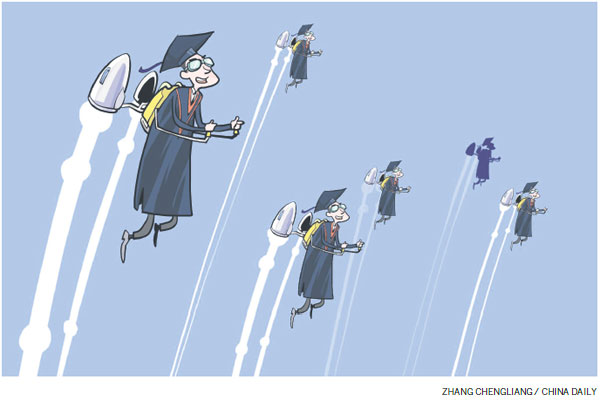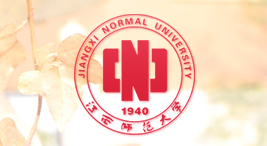China climbs the university ladder
Impressive performance in higher education suggests Europeans should be rushing to forge ties with the new academic giants
Only a few days ago Times Higher Education group published its very first ranking of top universities in the Asia-Pacific region for 2017, which shows significant achievement by Chinese universities.
The British publication has embarked on this regional ranking for the first time in order to publicize the advances made across the Asia-Pacific area in the university sector, and it should come as no surprise that the Chinese tertiary sector shines very brightly.
A whopping 34 Chinese universities have been ranked in Asia's top 100, 14 of which have comfortably made the top 50 too, and four have climbed as high as the top 10.

The crowning glory goes to Peking University, ranked second behind the National University of Singapore. Beijing-based Tsinghua University also makes the top five, ranked fourth.
Such a stellar performance by China's transitionary tertiary sector provides yet another unequivocal and incisive indicator of China's leading role in current and future integration across the entire Asia-Pacific region.
China's Belt and Road Initiative, revitalizing large parts of the traditional trading routes of the Silk Road, and the China-initiated and Beijing-based Asian Infrastructure Investment Bank have now been matched by the internationalization of the Chinese university sector as major advances that will contribute significantly to even greater Asian market attractiveness.
Advances in any education system inevitably lead to similar, or even greater, economic and social progress generally.
Times Higher Education ranking is to be respected highly and is the result of an extremely comprehensive methodology. A total of 38 countries across the Asia-Pacific region were included in this sizeable data collection and analysis exercise. More than 200 universities were sampled from 13 countries, evenly spaced across the region.

The QS World University Ranking methodology, arguably the most respected globally, formed the basis of the approach taken, with similar performance indicators used.
While Japanese universities total 69, it is the Chinese university sector that is rapidly emerging and advancing, with a total of 78 Chinese universities appearing in the rankings. Far more economically advanced nations, such as South Korea and Australia, only mustered 25 and 35, respectively in the rankings.
Such a major advance in China's tertiary sector, relative to Asia-Pacific competitors, presents an even greater market opportunity for the full range of European businesses and industries. For example, a more internationally competitive university sector across China will enable European companies to recruit even more talented locals who will be best placed to find the necessary balance between standardization and adaptation in brand-building strategies.
This transition toward international competitiveness in Chinese universities should lead to greater numbers of aspiring European professionals seeking to study in China, in preference to universities in their home countries.
European universities should also be studying this ranking, and other related rankings, in order to select the most suitable Chinese university partner. Research cooperation and collaboration, as well as student exchange programs, are among the exciting outcomes resulting from the most compatible, symbiotic Sino-European university co-branding partnerships.
European businesses, across the spectrum, should also be screening suitable Chinese university partners. Effective graduate recruitment and applied research cooperation and collaboration could also result from a suitable Sino-European university-industry link.
And there is no better Chinese university to commence such a screening process than Peking University, ranked second in Times list. Founded in 1898, it may surprise many in Europe - many inside the European university sector even - that the main teaching language for undergraduate university students is English, and many postgraduate programs are offered in English as well as Chinese.
All universities inevitably specialize in certain subject areas, and Peking is no exception. With a world-class reputation as a liberal arts university, Peking also performs very strongly in mathematics and science generally.
The main campus retains many features that portray its historical past such as picturesque pagodas, traditional houses, beautiful gardens and many other notable historical buildings.
Close behind in the rankings to Peking University is fellow Beijing-based Tsinghua University, ranked fourth.
The strengths of Tsinghua, probably the most academic and research-led Chinese university, lie firmly in science and engineering. But in spite of this reputation, Tsinghua is also internationally competitive in the arts and humanities.
According to the latest QS World University Rankings, Tsinghua ranks 25th, the highest Chinese and even Asian university.
But the European business and university communities need to be aware of the rise of lesser-known Chinese universities and the potential partnerships from which they could benefit considerably.
Two such Chinese universities are Xiamen, ranked 97th, and Xi'an Jiaotong, ranked 92nd. Not only are these part of a growing band of increasingly internationally competitive Chinese universities but they also highlight increasing geographical diversity across the Chinese mainland. Such diversity also suggests that cities and regions other than those in the first tier are fast becoming economically attractive.
Xiamen University, situated in Southeast China's fascinating Fujian province, is itself in a most attractive coastal city. Currently ranked 11th in China and consistently ranked in the top 20 Chinese universities, Xiamen achieves a star rating in a wide range of subjects, including economics and management, fine art, mathematics, journalism, chemistry and law. But even more significant, especially to potential European business and university partners, are the European Quality Improvement System and Association of MBA accreditations that the Xiamen School of Management has achieved.
EQUIS and AMBA accreditations provide further evidence of the international standards and global aspirations that now drive more and more of the Chinese tertiary sector.
Xi'an Jiaotong University, situated in Northwest China's Shaanxi province, not only provides a first-class education, but also one in which a real taste of historical China can be experienced. Previously named Chang'an, the city of Xi'an is the oldest of the four ancient capitals of China (Xi'an, Beijing, Nanjing and Luoyang) and was also the starting point of the ancient Silk Road. It is also, of course, home to the world famous Terracotta Army of Emperor Qin Shi Huang.
As well as having an excellent academic reputation across most subjects, European business and/or university partners should be aware that the university sits at the hub of the University Alliance of the Silk Road. This alliance acts as an umbrella over the Chinese government's Belt and Road Initiative and has an overarching influence in building educational cooperation and collaboration and supporting economic growth across countries along the traditional Silk Road route and beyond.
Potential partners should need no further information and should right now consider alliances with Xi'an Jiaotong University, given its influence over the Belt and Road Initiative.
Asian economic integration will dominate the world economy for the foreseeable future, with untold market opportunities for European education and industry, and the rise of Asian and Chinese universities in particular will only expedite this process of integration.
Those European businesses and universities smart and swift enough to forge long-lasting partnerships with suitable Chinese universities will no doubt position themselves very favorably to take full advantage of the imminent and momentous change in the economic and educational balance of power from West to East.
The author is a visiting professor at the University of International Business and Economics in Beijing and a senior lecturer at Southampton University. The views do not necessarily reflect those of China Daily.
(China Daily European Weekly 07/14/2017 page13)


















